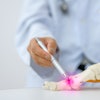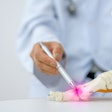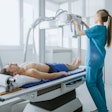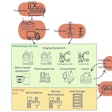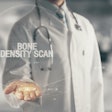
Radiology's interest in transitioning from analog x-ray to digital imaging has never been greater. It makes sense: About 70% of all radiology procedures are diagnostic screen-film x-ray exams. The ability to digitally convert and incorporate them into PACS promises major workflow efficiency gains.
For many administrators and clinicians in low-volume imaging environments, computed radiography (CR) has long been a good way to migrate smoothly and cost-effectively from screen-film to digital. Buying CR cassettes to replace analog ones is easy, and since one CR unit can handle three or four x-ray rooms, CR looks attractive to facilities concerned about the bottom line.
Another added benefit of CR is that it requires the least amount of retraining, since technologists can use it much like they've used analog cassettes. With the advent of desktop CR, hospitals can install a unit in a room, eliminating the need for technologists to walk back and forth between rooms carrying cassettes, and reducing the margin of error for mix-ups.
Any move to digital x-ray can positively impact a facility's overall operations, according to Deborah Imling, marketing manager for Philips Medical Systems of Andover, MA. "CR is a natural transition from film," she said. "And throughput efficiency jumps 10% to 15% when an imaging center goes from analog to CR."
A challenge from DR
In the late 1990s, vendors began touting flat-panel-based digital radiography (DR) systems as an alternative to CR, highlighting DR's better image quality and higher throughput. Some predicted that DR would replace CR as the primary digital x-ray solution.
But this hasn't come to pass; rather, it's become clear that CR and DR offer different solutions for different challenges. Although some argue that DR is becoming more attractive to smaller imaging facilities, DR continues to maintain a stronghold at teaching hospitals, imaging centers where an x-ray suite needs to be completely updated, and facilities suffering from technologist shortages. CR continues to attract those who want to enter the digital arena, while utilizing their existing equipment.
CR technology has evolved since 1983, when Fujifilm Medical Systems USA introduced the first system, which required 75 square feet of space and sold for $1.5 million. When the Stamford, CT-based company's CR technology patents expired in the late 1990s, the market landscape began to change as more companies competed to offer smaller and more efficient systems.
The National Electrical Manufacturers Association (NEMA) of Rosslyn, VA, estimates the U.S. CR market at $150 million this year. Another industry group, I3A of Harrison, NY, puts the size of the industry at closer to $300 million.
In 2003, the U.S. market grew by 54%, and about 30,000 CR devices are installed globally, according to Karen Tolson, global product manager for computed radiography at GE Healthcare in Waukesha, WI.
"CR is a powerful force," Tolson said. "It's a mature technology that's been around a long time, and it's a good starting point for facilities that want to go digital."
CR devices now range from about $40,000 for a desktop unit to about $150,000-$175,000 for the average multiplate reader, and image quality continues to improve. A single CR device can also integrate four x-ray rooms, making the per-room cost about $40,000. DR systems range from $120,000 for a basic unit up to $500,000 for a full room.
"If you invest in DR, you change out the whole x-ray room, and you can't use that DR device for more than one room," said Penny Maier, Fuji's national marketing director for x-ray. "Without patient volume, having faster technology doesn't make sense from a cost-benefit perspective for many imaging facilities."
DR does have a place, particularly in facilities performing 100 or more chest x-rays per day, for example. But its benefits over CR have been overstated, according to Gary Reed, president of Integration Resources, a PACS consulting and systems integration company in Lebanon, NJ.
"It's been said that DR can improve throughput over CR three to four times," Reed said. "But there are still patient-handling issues. You'd have to have patients lined up down the hall, ready to go (for that kind of throughput). Then you still have to position each person on the table, set the exposure, and acquire the images. DR does produce an image in a second or two, but those other workflow factors are still a reality."
Chicken and egg: which system comes first?
How does PACS affect CR and its implementation? More than half of the U.S. imaging market, 60%, has yet to adopt any digital technology at all, according to Scott Burkhart, business unit director at Philips.
The impetus to convert from analog to digital will only increase, so the question becomes how to do so rather than whether to do it at all. The first move to digital can be accomplished either via CR or DR technology or via PACS, depending on the existing resources available. If a hospital decides to install PACS first, however, usually digital x-ray technology isn't far behind, according to Reed.
"Few PACS are being purchased that don't include digital radiography as part of the package," Reed said. "Once a PACS commitment has been made, the addition of digital x-ray studies is a natural progression."
Once the process is set in motion, it's time to evaluate which digital route is best for the particular facility: installing CR, going directly to DR, or waiting for some future technology that combines the best of both worlds. Some hospital administrators might decide that the transfer time for changing from CR cassettes to a laser reader is negligible in the overall operations picture; others might feel the shortage of radiologic technologists more acutely and decide that eliminating cassettes is what's most crucial, Reed said.
Many companies are emphasizing the way CR technology, PACS, and DR interact. Orex Computed Radiography USA of Auburndale, MA, offers what it calls distributed CR that can be packaged with the company's PACS network and enables customers to place its line of compact CR units of varying throughput (20, 41, 60, or 75 plates per hour) in the x-ray room, thus eliminating the need for technologists to leave the room to read cassettes in between positioning the patient for the next view. Orex's ACL2, ACL4, and ACLxy CR devices can take orthopedic views and can be mounted on a cart for portability.
"Our philosophy is that the flow of the (CR) technology should be within the x-ray room," said Hillel Bachrach, Orex's CEO. "Our distributed CR concept is like a mini-DR: When you put CR in the room, you make the room as efficient as you can."
CR's future
Of particular interest for CR's future is the use of the technology for mammography, which would again offer the benefit of using existing x-ray equipment, but produce digital images. CR's wide dynamic range may prove helpful for women with dense breast tissue or implants.
Fuji researchers conducted a study this year with a new CR mammography algorithm that calculates and classifies the density of breast tissue. The study results were presented in June at the 7th International Workshop on Digital Mammography in Durham, NC, and showed a high correlation between density categorizations produced by the algorithm and those produced by radiologists.
Despite the potential benefits, CR for mammography presents its own challenges. As of yet, the Food and Drug Administration has not cleared any CR device for mammography use, although the technology is being used internationally. Fuji's CR for Mammography (FCR-M) unit has been installed at 1,500 sites outside the U.S. Its imaging view can be as large as 24 x 30 cm, and it uses Fuji's dual-side technology, which allows for light collection from both sides of the imaging plate. Philips also sells its CosimaX internationally for mammography applications.
In the coming year, more companies will connect CR technology to computer-aided detection (CAD) devices as well. Fuji has developed CAD software for its MV-SR 657 mammography viewer workstation. GE received FDA clearance for CAD with its CR/DR units during last year's RSNA show.
What else does the future hold for CR? The technology may end up blending with its cousin, DR. Although CR has often been the initial entry point into digital imaging, the gap between the two is closing as the technology continues to refine and DR continues to mature.
In fact, some companies believe the future points to integrated systems that incorporate both CR and DR technology, according to Todd Minnigh, marketing manager, digital capture for health imaging at Eastman Kodak Health Imaging in Rochester, NY.
"It used to be that everyone said, 'Is it CR or DR?'" Minnigh said. "It's both. They're complementary technologies, and you can't get along with just one of them. Customers are asking for integration, and more and more products are being developed to do just that."
To this end, Kodak has developed Capture Link, a network and software package that allows technologists to identify, process, and review CR plates from any reader on the Capture Link network. This flexibility gives users the ability to work with images at various points in the department, and enables simultaneous processing of multiple images as well.
Capture Link also gives technologists the ability to take a CR cassette into a DR room, use it for special views that might be more difficult with the DR unit (such as a cross-table shot), process the image at a Capture Link station, and return it to the DR room to be integrated into that study. Capture Link will be available for delivery this November, Minnigh said.
Agfa HealthCare of Greenville, SC, has developed CR50, a device that uses the company's patented scanhead technology, which integrates CR components into a circuit-board design and increases throughput from about 50-90 plates an hour to 130-180 plates an hour, according to Ted Ciona, senior marketing manager of CR solutions. Agfa hopes to roll out the unit at this year's RSNA show.
Agfa is also working on a needle-based image-phosphor CR device (based on cesium) for a new generation of products that will enable high-resolution CR in applications such as mammography and extremities imaging. By combining needle-based phosphor and scanhead technology, this device's image quality will be on par with the best DR on the market, Ciona said.
"CR and DR complement each other, rather than compete," said Eunice Lin, marketing manager, CR and PACS for Konica Minolta Medical Imaging of Wayne, NJ. "And since CR plate technology lends itself to continuous image quality improvement, it has the potential to close the gap with DR. It's usually workflow and budget, not image quality, that determines the choice between them."
By Kate Madden Yee
AuntMinnie.com contributing writer
September 16, 2004
Click here for an overview of CR offerings.
For more information on available CR or DR systems, check out AuntMinnie's Buyer's Guide for Cassette-Based Digital X-ray Systems.
Related Reading
CR mammography increases visibility of lesions in dense breasts, study finds, April 9, 2004
CR versus DR -- what are the options?, July 31, 2003
DR is tolerant, but not foolproof, June 10, 2003
Flat-panel unit beats CR for digital mammography, March 7, 2003
CR and DR cross swords in RT productivity debate, May 3, 2002
Copyright © 2004 AuntMinnie.com

